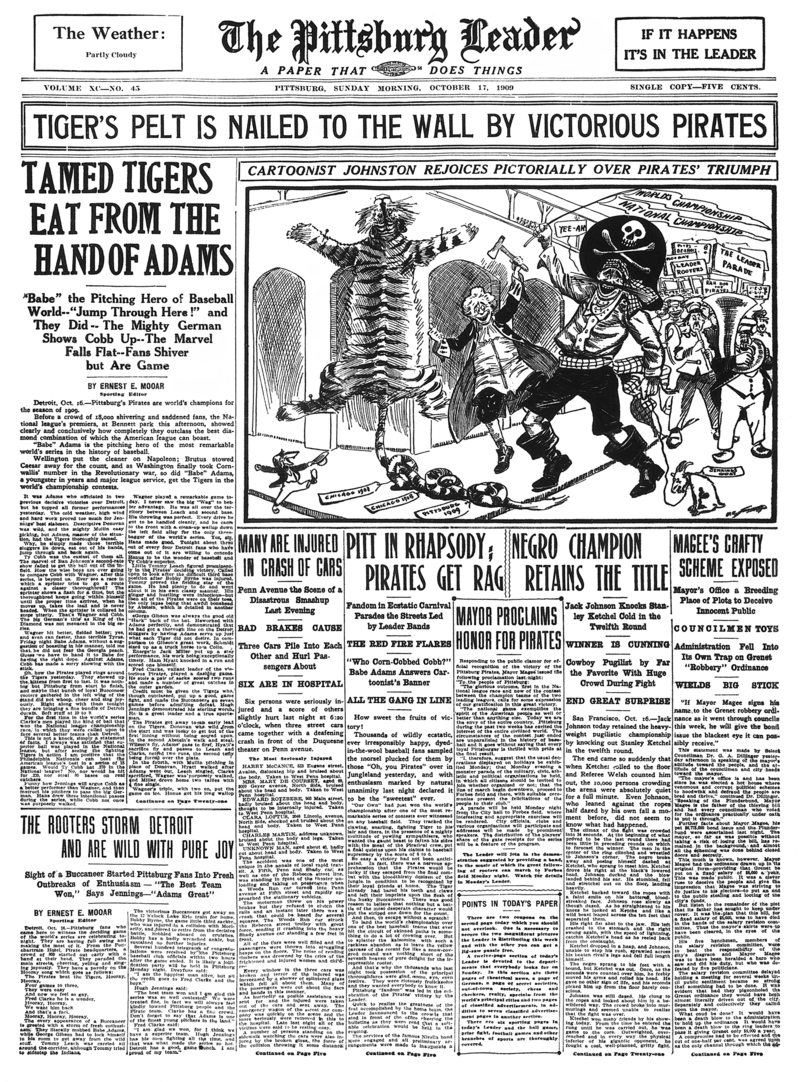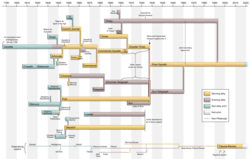Pittsburgh Leader
The Pittsburgh Leader was a major newspaper in Pittsburgh, Pennsylvania, United States, operating from 1864 to 1923.
 Front page, 17 October 1909 | |
| Founder(s) | John W. Pittock |
|---|---|
| Founded | 11 December 1864 (Sunday), 18 October 1870 (daily) |
| Political alignment | Independent |
| Language | English |
| Ceased publication | 14 February 1923 |
| City | Pittsburgh, Pennsylvania |
| Country | United States |
| |
History
John W. Pittock, a 21-year-old former newsboy, first published the Leader as a Sunday weekly on 11 December 1864.[1][2] A daily edition called the Evening Leader appeared on 18 October 1870 under the leadership of Pittock and partners John I. Nevin, Robert P. Nevin, and Edward H. Nevin.[3] The paper took a nonpartisan stance in political matters.[2]
Already in 1873, the Leader was listed in Rowell's American Newspaper Directory as having the largest daily circulation in Pittsburgh. It was also at the time the city's only daily with a Sunday edition, aside from the German-language Volksblatt.[4]
Following Pittock's death in 1881, members of the Nevin family conducted the paper for many years, finally selling it in 1906 to a team led by Alexander Pollock Moore, who became publisher and editor-in-chief. It was often said that ex-political boss William Flinn took part in the purchase and so jeopardized the paper's journalistic independence.[5] Muckraker Will Irwin, writing in Collier's magazine, accused Moore of turning the responsible, civic-minded Leader into a scandalmongering "yellow newspaper."[6]

The Leader and the Pittsburgh Dispatch published their last issues on 14 February 1923, being jointly purchased and absorbed by the other Pittsburgh papers: the Post, Sun, Gazette Times, Chronicle Telegraph, and the Press. At the time, advertisers and publishers had long regarded the Pittsburgh newspaper market as overcrowded.[7] Only four years after the demise of the Leader and Dispatch, mergers further narrowed the field of mainstream Pittsburgh dailies from five to three.
Notable contributors
Early in her career, author Willa Cather worked at the Leader as a telegraph editor and drama critic.
Investigative journalist and media critic George Seldes started out as a cub reporter at the Leader in 1909 at age 18. In a late-life memoir, he alleged that the Leader and other papers had allowed businesses to kill unfavorable stories in exchange for advertising payments.[8][9]
Actress Lillian Russell, who was married to publisher Moore, had a beauty advice column called "Lillian Russell's Philosophy."[10] Russell's death in June 1922 possibly contributed to Moore's decision to discontinue the paper; Moore said in his farewell column eight months later that "since June of last year I have not had the same incentive to continuous effort that previously inspired me."[7]
Arthur G. Burgoyne or cartoonist Fred Johnston, or both, created the character Father Pitt as a personification of the city of Pittsburgh. The character was adopted by numerous editorial cartoonists in other Pittsburgh papers.[11][12]
References
- Fuld, Melvin (February 1970). "Pittock's Civil War Tokens". The Token Collector's Page. The Numismatist. 83 (2): 185.
- Killikelly, Sarah Hutchins (1906). The History of Pittsburgh: Its Rise and Progress. B.C. & Gordon Montgomery Company. pp. 493–494.
- Durant, Samuel W. (1876). History of Allegheny County, Pennsylvania. Philadelphia: L. H. Everts & Co. p. 129.
- Rowell's American Newspaper Directory. New York: Geo. P. Rowell & Co. 1873. p. 194.
- "Pittsburg Deal Removes Two Big Newspapers". The Fourth Estate: A Weekly Newspaper for Advertisers and Newspaper Makers. 17 February 1923. p. 16. Retrieved 9 March 2014.
- Irwin, Will (22 July 1911). "The American Newspaper: A Study of Journalism in Its Relation to the Public". Collier's. 47 (18): 26.
- "Pittsburg Deal Removes Two Big Newspapers". The Fourth Estate: A Weekly Newspaper for Advertisers and Newspaper Makers. 17 February 1923. p. 2. Retrieved 9 March 2014.
- Seldes, George (1987). Witness to a Century. ISBN 978-0-307-77542-9.
- Dicke, William (3 July 1995). "George Seldes Is Dead at 104; An Early, Fervent Press Critic". The New York Times. Retrieved 26 February 2014.
- Thomas, Clarke M. (2005). Front-Page Pittsburgh: Two Hundred Years of the Post-Gazette. Pittsburgh: University of Pittsburgh Press. p. 137. ISBN 0-8229-4248-8.
- Andrews, J. Cutler (1936). Pittsburgh's Post-gazette: "The first newspaper west of the Alleghenies". Boston: Chapman & Grimes. p. 255.
- Thomas, Clarke M. (2005). Front-Page Pittsburgh: Two Hundred Years of the Post-Gazette. Pittsburgh: University of Pittsburgh Press. p. 144 and p. 319 footnote 8. ISBN 0-8229-4248-8.